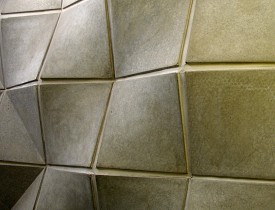Investing Wisely in Floor Tile

According to John Asselin, owner of Hampshire Tiling & Floor Company in Northampton, MA, the first tiling investment question centers on finding a tile you like. “Finding the right product is the first step,” said Asselin. While that may sound simple, the choices are many, and if installed correctly, you will be living with your choice for a long time.
Once the choice is made, Asselin said you will be best served if you find a tiling contractor to do the work. “Hire a professional setter. A lot of people think they can set tile, but there are many different requirements and codes that must be followed,” said Asselin.
However, if you are a very experienced do-it-yourselfer, Asselin recommends becoming very familiar with the guide published by the Tile Council of North America Inc. The TNCA describes their handbook as “consensus guidelines for ceramic tile installation.”
Also included in the handbook is a brochure that contains information on environmental sustainability and cost evaluation relating to tiling. For example, tiling can actually contribute LEED points to a project. LEED is the internationally recognized green building certification system.
Choice of Tile for Flooring: Porcelain or Ceramic?
“Typically, porcelain tile is the best choice for flooring. It’s stronger, as it’s fired at a higher temperature, and is the most durable,” said Asselin. Asselin added that porcelain’s durability is nearly “bullet proof,” and is the best choice for kitchens and high traffic areas such as entryways.
The next consideration, especially for tiling in a kitchen or high traffic area is to select a tile that is known as “through body porcelain.” “The color goes all the way through the tile. So if you drop something on the floor or chip the tile in some other way, it doesn’t really show,” said Asselin.
Ceramic tile is softer and is best used in either low-traffic areas or for walls and backsplashes.
In terms of pricing, porcelain and ceramic tiles cost about the same. What will affect the pricing is how decorative the tile, and the pattern chosen for the setting. “For example, if you want the setting to be a diamond pattern instead of a traditional square pattern,” said Asselin.
Investing in Stone or Glass Tile
In terms of flooring, Asselin said that while someone may be going for a certain “look” with stone, expense and high maintenance are considerations. “Stone tends to be a more expensive choice (for tiles). They need to be sealed on a regular basis. They need to be impregnated with multiple coats of sealant every couple of years,” said Asselin. “You also don’t want to use stone on high traffic areas or grease on the floor,” he said.
In terms of glass, Asselin said that glass tiling is primarily used for decorative purposes, walls, and backsplashes.
Get the Most from Thin Set and Grout
Thin set is the adhesive used to apply your tiles to the floor or walls. Asselin recommends a latex-modified thin set. “Latex gives the adhesive a little bit more mobility while setting,” he said.
The grout is best if it is primarily epoxy as opposed to an epoxy emulsion, which is a mixture of cement and epoxy resins according to TNCA.
Asselin also recommends a stain-resistant grout (which usually contains Teflon). Asselin said that “regular sanded grout, will stain within five to six months. Use the more expensive grout to begin with; it will save you time and effort in terms of maintenance. And it will look better,” he said.
Asselin emphasized again to find a professional to work with for both setting and design for the best possible outcome.
Looking for a Pro? Call us (866) 441-6648

Tile Contractors Experiences

Thoroughly Modern Bathroom Remodel

Shower Tile Rehab In Hotel Guest Rooms



